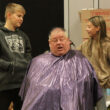Sean C. Morgan
The City Council held a public hearing on Oct. 11 to consider revisions to the city’s conditional use ordinance, which sets guidelines for uses that are normally allowed but could pose potential problems within an area.
The Planning Commission held a public hearing on the ordinance on Oct. 3.
The council held the first reading of the ordinance and will need to read the ordinance two more times before it can be approved. The third reading would typically be held followed by a decision on Nov. 8.
The Planning Commission started reviewing the ordinance in a series of work sessions last year following the completion of the new sign ordinance, said Community Development Director Carol Lewis. The commission went through the ordinance line by line, draft after draft, debating a variety of issues.
What came out was a complete rewrite of the ordinance.
Among the changes are the elimination of more than four pages of specific standards for different types of conditional uses.
“It didn’t really have clear and objective criteria for decision making,” Lewis said.
Under the existing ordinance, a conditional use is a use of land or a structure that is normally appropriate, desirable or necessary in a zone where it is permitted, while at the same time, it may be a potential nuisance or health and safety hazard.
For these uses, developers may obtain a permit through a public hearing process before the Planning Commission to ensure that the best interests of surrounding property, neighborhoods and city are safeguarded.
The proposed ordinance eliminates this language and notes that conditional uses, which are identified within specific zoning ordinances, are reviewed on a case-by-case basis and analyzed for potential impacts to surrounding land use and public facilities.
Under the proposal, a conditional use is described as an activity that is basically similar to other uses permitted in the zone. The ordinance provides standards and procedures to ensure that the conditional use will not be detrimental to the public health, safety and general welfare of adjacent properties.
Conditions may be imposed on the use to mitigate potential negative impacts, Lewis said.
The proposed ordinance sets clear criteria and describes better what information is needed to determine what the potential negative impacts of a use may be, Lewis said. “What helps the Planning Commission understand how it’s going to impact a neighborhood.”
The application process has been changed to make sure that information gets to the Planning Commission, Lewis said.
The proposed ordinance spells out a process for the Planning Commission to terminate a conditional use permit, Lewis said. Previously, it simply said that the Planning Commission can revoke or modify a permit, but it outlined no process or criteria.
Additionally, the Planning Commission has spent the past year discussing how a conditional use permit may be transferred in cases of a new owner or business on a specific property.
Generally, as long as the new owner will comply with the conditions, the permit may be transferred, Lewis said.
The new ordinance will eliminate a limitation that prevented applicants from reapplying for a permit for a year if their permits were denied.
“None of us could think of a good reason why they couldn’t apply again,” Lewis said, so the section was struck.
More than four pages of specific standards were also struck because they are redundant, Lewis said. Many specific standards, such as those for manufactured homes and daycare facilities, are handled by the state.
In other cases, the conditions set on a use will mitigate the concerns addressed by the old standards, Lewis said.
For more information about the new ordinance call (541) 367-8113. To view a copy of the ordinance, visit the planning office at City Hall at 1140 12th Ave.




